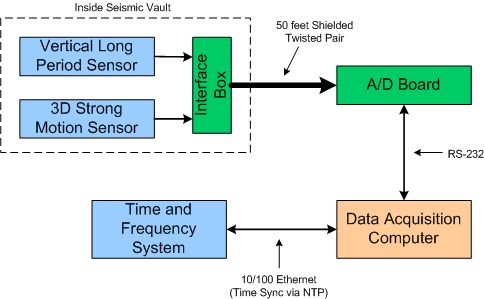Bryant Labs
Seismology
![]()
You too can monitor seismic activity anywhere around the world with some relatively simple equipment which can be purchased for a few hundred dollars. The system I've built can detect earthquakes anywhere in the world over about magnitude 6.0. I happen to live less than 50 miles from a very active area at "The Geysers", a natural geo-thermal energy production area on the border of Lake and Sonoma Counties in northern California. It provides a constant source of low level earthquakes to keep me amused. I can see quakes down to magnitude 2.5 up there, and down below 2.0 if they are in Santa Rosa.
![]()
Here's a block diagram of my Seismic Monitoring system hardware.
 My system consists of a long period (about 50 second) vertical sensor based
on plans of a unit built by the late Sean-Thomas Morissey. See the link below
to visit his site. I modified his STM-8 design to match the materials I had
available. For construction details and pictures, go to the
Vertical Seismometer page
My system consists of a long period (about 50 second) vertical sensor based
on plans of a unit built by the late Sean-Thomas Morissey. See the link below
to visit his site. I modified his STM-8 design to match the materials I had
available. For construction details and pictures, go to the
Vertical Seismometer page
I also have a 3 axis accelerometer sensor which doesn't show much most of the time, but it will record large earthquakes which would cause the sensitive vertical sensor to go into overload.
Both sensors are connected to an interface box. For the vertical sensor, this provides the active feedback which effectively lengthens the period of the sensor from its natural period of one second to about 50 seconds. For the accelerometers, this is just an amplifier and buffer. The schematics for the interface box can be found on the Seismometer Electronics page. The Seismometers and the interface box are housed in a small dog house type structure that I euphemistically refer to as a "Seismic Vault".
It feeds signals into an A/D converter board via about 50 feet of shielded twisted pair cable. The board is sold by Larry Cochrane (see link to his website below). It is connected to my data acquisition PC via a serial port. The PC is running Larry's WinSDR software to record the seismic activity to the hard disk.
The Data acquisition computer is synchronized to my Precise Time and Frequency System via NTP. By doing this, I can be sure that my measurements of the time-of-arrival of the seismic waves are correct to UTC. This is important when comparing results with other stations.
To see a couple of recordings of earthquakes I made with the equipment here, follow this link
![]()
Here are some of my favorite links to Seismology information:
![]()
Last Revised: 2-January-2006